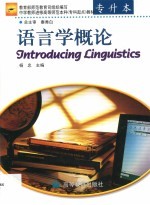

语言学概论 英文本PDF电子书下载
- 电子书积分:9 积分如何计算积分?
- 作 者:杨忠主编
- 出 版 社:北京:高等教育出版社
- 出版年份:2002
- ISBN:7040115360
- 页数:165 页
CHAPTER 1 Language and Linguistics: an Overview 1
1.1 What is language? 1
1.2 Features of human language 2
1.3 Functions of language 5
1.4 Types of language 6
1.5 The myth of language: language origin 8
1.6 Linguistics: the scientific study of language 9
TUTORLAL ACTIVITIES/QUESTIONS 13
MINI-PROJECTS 13
CHAPTER 2 Phonetics: the Study of Speech Sounds 14
2.1 The study of speech sounds 14
2.2 The sound-producing mechanism 14
2.3 Phonetic transcription of speech sounds 16
2.4 Description of English consonants 17
2.5 Description of English vowels 19
2.6 Phonetic features and natural classes 21
TUTORLAL ACTIVITIES/QUESTIONS 22
MINI-PROJECTS 23
CHAPTER 3 Phonology: the Study of Sound Systems and Patterns 24
3.1 The study of sound systems and patterns 24
3.2 Phonemes and allophones 24
3.3 Discovering phonemes 25
3.4 distinctive features and non-distinctive features 27
3.5 Phonological rules 28
3.6 Syllable structure 29
3.7 Sequence of phonemes 30
3.8 features above segments 31
TUTORLAL ACTIVITIES/QUESTIONS 33
MINI-PROJECTS 35
CHAPTER 4 Morphology: the study of Word Structure 36
4.1 Words and word structure 36
4.2 Morpheme: the minimal meaningful unit of language 36
4.3 Classification of morphemes 37
4.4 Formation of English words 38
TUTORLAL ACTIVITIES/QUESTIONS 43
MINI-PROJECTS 44
CHAPTER 5 Syntax: the Analysis of Sentence Structure 45
5.1 Grammaticality 45
5.2 Knowledge of sentence structure 46
5.3 different approaches to syntax 47
5.4 Transformational-generative grammar 49
5.5 Systemic-functional grammar 60
TUTORLAL ACTIVITIES/QUESTIONS 69
MINI-PROJECTS 72
CHAPTER 6 Semantics: the Analysis Meaning 73
6.1 The study of meaning 73
6.2 Reference and sense 74
6.3 Classification of lexical meanings 75
6.4 Lexical sense relations 77
6.5 Describing lexical meaning: componential analysis 80
6.6 Words and concepts 81
6.7 Semantic relations of sentences 83
6.8 Metaphors 85
TUTORLAL ACTIVITIES/QUESTIONS 89
MINI-PROJECTS 92
CHAPTER 7 Pragmatics: the Analysis of Meaning in Context 93
7.1 The pragmatic analysis of meaning 93
7.2 Deixis and reference 94
7.3 speech acts 96
7.4 Cooperation and implicature 98
7.5 The politeness principle 99
7.6 The principle of relevance 101
7.7 conversational structure 103
TUTORLAL ACTIVITIES/QUESTIONS 106
MINI-PROJECTS 107
CHAPTER 8 Language in Social contexts 108
8.1 Sociolinguistic study of language 108
8.2 Varieties of a language 108
8.3 Grades of formality 111
8.4 Languages in contact 112
8.5 Taboos and euphemisms 113
8.6 Language and culture 114
8.7 Communicative competence 116
TUTORLAL ACTIVITIES/QUESTIONS 117
MINI-PROJECTS 117
CHAPTER 9 Second Language Acquisition 118
9.1 What is second language acquisition? 118
9.2 Factors affecting SLA 119
9.3 Analyzing learners language 122
9.4 Explaining second language acquisition 124
TUTORLAL ACTIVITIES/QUESTIONS 127
MINI-PROJECTS 128
CHAPTER 10 Linguistics and Foreign Language Teaching 129
10.1 foreign language teaching as a system 129
10.2 Contribution of linguistics: applications and implications 131
10.3 Linguistic underpinning of syllabus design 132
10.4 Method as integration of theory and practice 133
10.5 Linguistics the professional development of language teachers 136
TUTORLAL ACTIVITIES/QUESTIONS 137
MINI-PROJECTS 139
AppendixⅠ Families/Groups of Languages 140
AppendixⅡ The Indo-European Language Family 142
Bibliography 144
Suggested Solutions to Tutorial Questions 148
An English-Chinese Glossary 156
- 《全国高等中医药行业“十三五”创新教材 中医药学概论》翟华强 2019
- 《程序逻辑及C语言编程》卢卫中,杨丽芳主编 2019
- 《海绵城市概论》刘娜娜,张婧,王雪琴 2017
- 《幼儿园课程资源丛书 幼儿园语言教育资源》周兢编 2015
- 《药学概论》于海平主编 2019
- 《高等学校“十三五”规划教材 C语言程序设计》翟玉峰责任编辑;(中国)李聪,曾志华,江伟 2019
- 《音乐语言的根基》张艺编著 2019
- 《新闻心理学概论 第6版》刘京林 2019
- 《认知语言学视野的抽象方位结构研究》曹爽著 2019
- 《激活语言思维》李蒨,王宏年,汤青编著 2017
- 《全国高等中医药行业“十三五”创新教材 中医药学概论》翟华强 2019
- 《培智学校义务教育实验教科书教师教学用书 生活适应 二年级 上》人民教育出版社,课程教材研究所,特殊教育课程教材研究中心编著 2019
- 《指向核心素养 北京十一学校名师教学设计 英语 七年级 上 配人教版》周志英总主编 2019
- 《习近平总书记教育重要论述讲义》本书编写组 2020
- 《办好人民满意的教育 全国教育满意度调查报告》(中国)中国教育科学研究院 2019
- 《高等数学试题与详解》西安电子科技大学高等数学教学团队 2019
- 《北京生态环境保护》《北京环境保护丛书》编委会编著 2018
- 《教育学考研应试宝典》徐影主编 2019
- 《语文教育教学实践探索》陈德收 2018
- 《家庭音乐素养教育》刘畅 2018
